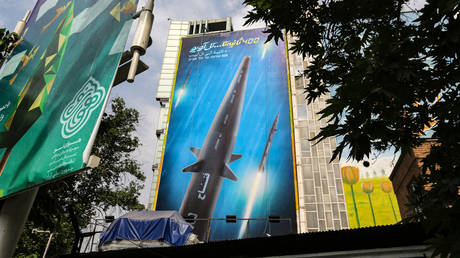
Iran’s newest hypersonic missile reportedly makes use of a technology possessed by very few nations in the world
Iran’s Islamic Revolutionary Guard Corps (IRGC) unveiled the nation’s cutting-edge hypersonic missile at a ceremony in Tehran attended by Supreme Leader Ayatollah Ali Khamenei on Sunday, the local media reported. The projectile reportedly makes use of a rare hypersonic glider technology.
The missile was presented at the Ashura Aerospace Science and Technology University during an exhibition showcasing the Islamic Republic’s advancements in aerospace technologies. According to the IRNA news agency, the missile dubbed Fattah-2 is equipped with a hypersonic glider warhead that places it “in the HGV… class of hypersonic weapons.”
The Iranian media reported that the Islamic Republic has become the fourth nation in the world to make use of such a technology.
A hypersonic glide vehicle, or HGV, is a type of warhead that allows it to maneuver and glide at hypersonic speed. It is usually mounted on ballistic missiles and can significantly change its flight trajectory after launch, which makes it a much harder target for a potential enemy’s missile defense systems than a traditional ballistic warhead traveling in a more predictable arc trajectory.
Very few nations have operational HGV missiles to date.One of them is Russia, which possesses the ‘Avangard’ gliders mounted on its silo-based intercontinental ballistic missiles like ‘Sarmat.’ The Russian HGV is capable of flying between 20 and 27 times faster than the speed of sound or between 24,000 and 33,000 kilometers per hour and has an explosion yield of up to two megatons, which is more than 100 times greater than the explosion produced by the US nuclear bomb dropped on the Japanese city of Hiroshima.
In 2019, China officially took its DF-ZF HGV missile into service. Mounted on a road-mobile medium-range ballistic missile, the Chinese hypersonic glider can travel up to 10 times faster than the speed of sound or at a speed of 12,360 kilometers per hour and can carry a nuclear charge.
The US was expected to have its ‘Dark Eagle’ Long-Range Hypersonic Weapon (LRHW) enter service in September, but its fielding was delayed due to a scrapped critical test of its glide vehicle. The weapons system is still expected to become operational by the end of the year, according to media reports.
Little is known about Iran’s Fattah-2 missile, as the national media provided very few details on the projectile’s technical characteristics. Its predecessor, the Fattah missile that was officially unveiled less than six months ago, on June 6, had a range of 1,400 kilometers and could travel between 13 and 15 times faster than the speed of sound.
The commander of the IRGC Aerospace Force, General Amir Ali Hajizadeh, said later in June that the projectile’s range could be increased to 2,000 kilometers. Such an operational range could potentially allow Iran to reach the territory of Israel, a nation Tehran considers to be its arch-enemy. According to the Iranian media, the Fattah missile was also capable of penetrating through a potential enemy’s air defenses and destroying them.




